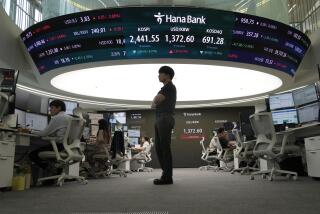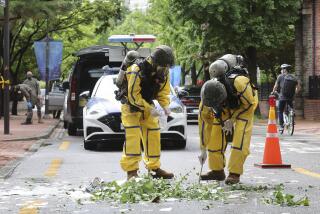Street Protests and Public Suicides Attest to Growing Labor Unrest in South Korea
SEOUL â One union leader hanged himself from the top of a 130-foot-tall crane, his body left to dangle gruesomely over the shipyard where he had worked since he was a teenager. At the same shipyard, another activist hurled himself off the dock and plunged to his death.
Still another committed suicide by drenching himself with paint thinner and setting himself on fire during a demonstration last month in downtown Seoul.
For the record:
12:00 a.m. Dec. 3, 2003 For The Record
Los Angeles Times Wednesday December 03, 2003 Home Edition Main News Part A Page 2 1 inches; 57 words Type of Material: Correction
South Korea protest -- A caption accompanying an article in Saturdayâs Section A about protests and public suicides amid growing labor unrest in South Korea incorrectly stated that demonstrators were carrying placards bearing the photographs of activists who had committed suicide. The photographs were of Samsung Group Chairman Lee Kun Hee and his son Lee Jae Yong.
Four South Korean labor activists have killed themselves since late September, and a fifth is lying near death in the burn unit of a hospital. Four foreign workers also have committed suicide this month in protest of South Korean labor policies.
In September, a South Korean farmer stabbed himself to death at a World Trade Organization conference in Cancun, Mexico.
These spectacularly public suicides, along with increasingly disruptive protests on the streets, are an unmistakable sign of growing labor unrest in South Korea.
âThe worst year of labor discontent since 1990,â is how the English-language newspaper Korea Herald described 2003, citing South Korean Labor Ministry statistics reporting 305 strikes and job actions through the first half of November.
In years past, the South Korean labor movement gained notoriety for its outrageous tactics. Suicides were a traditional form of protest, as was biting off a fingertip to write oneâs grievances in blood. But such practices appeared to be declining because of rising wages, improved working conditions and the overall democratization of the country.
Labor analysts believe that the reemergence of labor radicalism has less to do with the economy than with politics. Although South Korea is indeed recovering from a mild recession, the election last year of a maverick labor lawyer, Roh Moo Hyun, as president raised high expectations in the unions of a pro-labor atmosphere in South Korea.
âTo say that we are disappointed is an understatement,â said Kim Tae Yeon, executive director for policy of the Korean Confederation of Trade Unions, the most radical of the labor umbrella groups. âWe didnât think that President Roh would bring about incredible change, but we didnât think the government would go to extremes in oppressing workers.â
The group is particularly upset that employers have taken to filing lawsuits against union leaders seeking compensation for lost productivity during strikes.
After a railroad strike in June, Kim said, 40 union leaders were sued personally for damages of nearly $7 million. In some cases, the courts have impounded union leadersâ salaries or assets.
The most disturbing case involved Kim Ju Ik, a 40-year-old official of the Hanjin Heavy Industry Workers Union in the seaport of Pusan. After his salary was garnished and a lien on his house filed, Kim installed himself in the tiny cockpit of a crane in the shipyard. For 127 days, fellow union activists used pulleys to hoist up food and water and bring down garbage and human waste from the crane.
In the early morning of Oct. 17, his body was found dangling from the cockpit.
âHe had lost all hope and felt weary. I think he felt there was no other way to tell the world about his grievances,â his sister, Kim We Suk, said.
Kimâs body remained on the crane -- wrapped in dry ice by his relatives to prevent decomposition -- for more than a month in keeping with instructions in his will that he not be moved until his grievances were settled with the company.
The strike ended this month with the shipbuilder agreeing to withdraw the damage suits, rehire fired workers and raise wages, and the union permitted the removal of the corpse.
Thousands of union members marched through the streets of Pusan Nov. 16 during a joint funeral held for Kim and Kwak Jae Gyu, the activist who jumped off the dock, in a sympathy suicide, shortly after Kimâs death.
About 50 labor activists have killed themselves since 1970, when a garment worker in Seoul set himself on fire. His death later became the inspiration for the founding of the Korean Confederation of Trade Unions.
The recent suicides have been accompanied by an upsurge in protests.
In a boisterous demonstration reminiscent of the turbulent 1980s, union activists hurled Molotov cocktails and swung metal pipes at police this month in downtown Seoul, in a protest over the suicides.
Several days later, about 50,000 workers walked off their jobs, forcing the countryâs largest automobile maker, Hyundai, to shut its assembly lines for a day. More demonstrations are promised.
Some economists are extremely critical of the labor movement for turning up the heat when South Korea is in danger of losing manufacturing jobs to lower-cost competitors such as China.
âKorean workers should be thinking more about raising their level of productivity. This could be a serious misjudgment on the part of labor,â said Yoon Deok Ryong, an economist with the Korea Institute for International Economic Policy.
The Korean Chamber of Commerce and Industry reported last week that 1,800 South Korean companies moved factories out of the country in 2002.
Lim Sung Hoon, an economist with the Korea Labor Institute, said the new militancy is not engendering the kind of public support it once did.
âIt will be difficult for them to buy sympathy with these same old tactics,â Lim said. âThis might have worked in the past when the poor worked under harsh conditions, but not now.â
More to Read
Sign up for Essential California
The most important California stories and recommendations in your inbox every morning.
You may occasionally receive promotional content from the Los Angeles Times.










